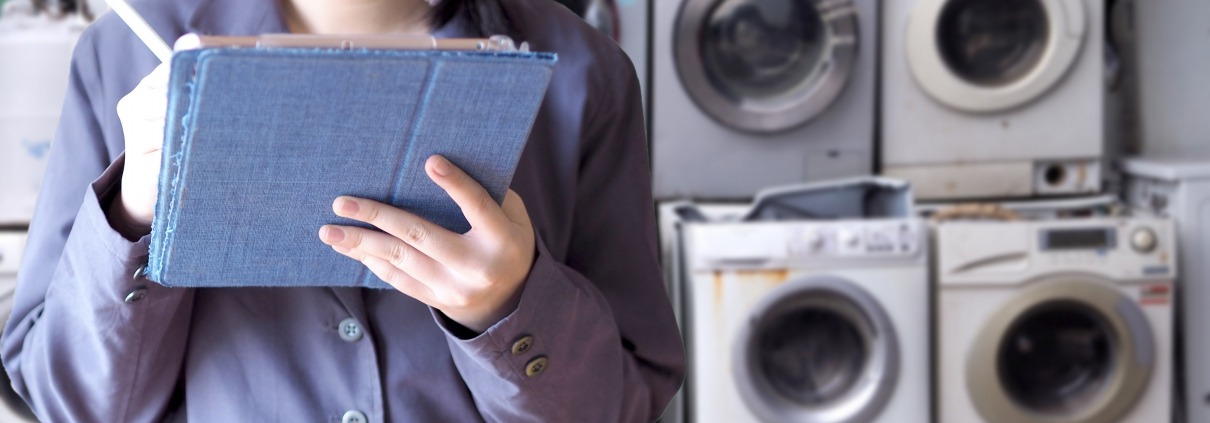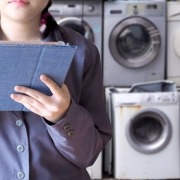Don’t Throw It Away! A Guide on How to Recycle Washer Motors
Steven E / Thursday June 29, 2023
“A stitch in time saves nine” – this adage is a reminder of the importance of being proactive and taking actions that will save us from future troubles. Recycling old washer motors is a sure way to save up on resources, and save energy. All of this while also protecting our environment. This article aims to provide a comprehensive guide on recycling washer motors properly.
Why Should I Recycle Them?
Electric motors are key components of washing machines. They power the drum and agitator of the machine. The purpose of electric motor recycling is to reduce waste and generate income. Additionally, it can also help promote sustainability by prolonging the life cycle of electric motors. By dismantling and recycling washer motors, components such as copper are recoverable.
Benefits Of Recycling Washer Motors
Recycling electric motors from washing machines can be a great way to help the environment. By recycling these motors, it is possible to create an energy-efficient model of a washer. Furthermore, recycled washer motors are useable in the production of new washers. This enables manufacturers to reduce their production costs while still providing high-quality products. Additionally, recycling these motors helps reduce the need for harmful chemicals used during the production process.
It is also important to consider the financial benefits of recycling washer motors. Recycled parts often have a much lower price than new parts. Lower prices make purchasing them more affordable. By finding parts from other sources such as scrapyards, it is possible to save more money on repairs. When you recycle electric motors it helps divert waste materials away from landfills. This prevents them from polluting our environment with toxic substances.
Preparation Steps For Recycling
Recycling an electric motor from a washer requires proper preparation. First, remove the electric motor from the washer and disassemble it. Depending on the model of the motor, it may need a screwdriver or other tools. Taking it apart helps to access all components for recycling. This includes removing any housing and unscrewing bolts.
Next, separate all materials that are recyclable from those that aren’t. It is important to identify which materials are recyclable so. By identifying them you can dispose of them responsibly. The washer motor contains recyclable components such as copper windings and scrap metal. However, local regulations may need you to dispose of certain materials instead of recycling them.
Finally, remove any oil, dirt, or debris before taking parts for processing. It can help maximize their value when sold as scrap materials. Use tools such as wire brushes or compressed air to clean off any residue.
Tools And Materials Needed
The process of disassembly is like peeling an onion. Layer by layer, to uncover individual recyclable items and materials.
The first step is to gather the necessary tools like screwdrivers, pliers, wrenches, and other hand tools. It is important to wear protective gear like gloves and glasses while working on the motor. Once you gather all the necessary items, it’s time to begin taking apart the washing machine motor.
Safety Protocols
When recycling a washer motor, it is important to consider safety protocols. Before beginning the process of dismantling and recycling, ensure that any work done is in compliance with local ordinances. Additionally, wear protective clothing such as work gloves and safety glasses. Secure the appliance before starting any dismantling work.
Once at the recycling center, follow all instructions for unloading and disposal. Make sure the area where the item is being unloaded is clear of potential hazards and debris. If unable to safely complete the task on-site, contact a professional for assistance.
Before beginning any further steps in recycling a washer motor, review all safety protocols for completing the task. Taking precautionary measures can cut potential risks associated with disassembling an old machine.
How To Dismantle The Motor
To dismantle and recycle the motor, it is essential to separate all components. This step-by-step guide will help make this task easier.
- Unscrew the screws and bolts that keep the body of the washer together.
- Carefully separate all of the parts including wires, hoses, and belts.
- Disconnect any electric or gas connections associated with the motor.
- Remove any debris, such as dirt and dust, from around and inside the motor’s components.
Doing this will also help reduce energy consumption during the recycling process. It also increases efficiency when using pick-up services to transport motors for disposal or reuse purposes.
Separate The Components
When it comes to recycling washer motors, the first step is to separate the components. Many washing machines, air conditioners, and large appliances contain a range of parts that may be recyclable. They may also have components that need safe disposal.
Unscrew the aluminum casing slowly and carefully so as not to damage any interior parts. Then cut all exposed wires with insulated pliers or scissors. Collect all removable components such as switches, dials, nuts, and bolts for safe disposal or recycling. Make sure to also separate metal and plastic components with care.
Once you separate the components, organize them into categories. Categories include materials such as metals, plastics, electronic devices, wiring, and miscellaneous items. It is also important to check if any local waste facilities offer specific types of recycling services. This makes the process even simpler.
Sorting The Parts For Recycling
Sorting the parts for recycling is a crucial step in recycling washer motors. As with any task, it is important to begin by gathering the necessary tools for the job at hand. Before beginning the sorting process, grab a set of screwdrivers, pliers, and wrenches. Additionally, an old-fashioned toolbox can provide a reliable storage solution for these tools.
The first step is to disassemble each part of the scrap from the motor. Sort them into piles based on type. Place metals such as copper, aluminum, and steel in separate containers. Any non-metallic parts, dispose of properly. You can send them to a recycling center that specializes in these materials.
Disposal Of Hazardous Waste
Having sorted the parts of the motor, it is now possible to identify and dispose of any hazardous materials. Some of these components may contain toxic metals such as lead, mercury, or cadmium. Additionally, other hazardous materials such as oils and solvents may be present.
Drain any fluids from the motor into a suitable container. Handle these substances carefully to avoid potential contamination of soil or water sources.
Removing Oil And Grease Residue
After storing reusable parts of the washer motor, the next step is to remove any oil and grease residue. This is necessary so that the motor can be safely shipped. Before beginning, it is important to wear protective gloves and safety goggles. Additionally, it is also advisable to work in a well-ventilated area. Some of the chemicals used may have an unpleasant odor or may be toxic if inhaled.
The first step in removing oil and grease residue is to use a degreaser or solvent on the parts of the motor. Degreasing agents are available at most hardware stores. Apply according to the manufacturer’s instructions. After application, allow the degreaser to sit for several minutes. Then wipe it off with a clean cloth. It is important not to leave any excess degreaser on the parts. This could cause damage during shipping.
Another method for removing oil and grease residue from washer motors and pumps is using a pressure washer. Pressure washers are more powerful than degreasers. After using either method, it is important to wipe off any excess moisture with a clean cloth.
Finding A Reputable Recycling Facility
The next step is to find a reputable recycling facility. It is important to research different facilities and read reviews before choosing one. The best way to determine the credibility of a recycling center is by reading reviews online.
Some companies may be willing to pick up unwanted items at no extra charge. Make sure you make arrangements in advance. Some avenues for recycling may need you to ship the parts so following all protocols is important.
Preparing For Shipment
Before shipping, it is important to ensure the part is prepared for transportation. The first step is to secure all internal components. You can use plastic ties or other securing mechanisms designed for the purpose.
Wrap the motor in bubble wrap or another form of protective wrapping. This will prevent any damage that may occur during transit.
It is also important to check for any loose wires or parts that may have dislodged. Remove any loose parts and packed them separately from the unit or motor itself.
Finally, before shipment:
- Label all packages clearly with intended destination details
- Attach invoice information and packing lists to each package
- Include a return address label on each package
- Include any special instructions if applicable
This whole system will help to ensure that delivery is as timely and efficient as possible.
Packaging And Labeling Guidelines
Recycling a washer motor is like putting together the pieces of a puzzle. It requires attention to detail, proper packing and labeling, and tracking. Below are some guidelines for packaging and labeling your washer motor:
- Label each box with a description of what’s inside.
- Pack the motor securely with enough cushioning materials to prevent movement during transport.
- Check that all parts have been included in the package.
It is important to provide accurate details about the item being recycled for paperwork purposes. This helps to avoid confusion or delay when it comes time for recycling. So, make sure that any labels you attach include your name, contact information, and address. Other pertinent details such as the size or weight of the package are also advised to be added.
Conclusion
Recycling washer motors is a great way to reduce waste and preserve resources. It also helps to preserve the environment. Reusable materials are processed in a more efficient manner than those that are thrown away. With the right preparation and safety protocols, individuals can recycle their washer motors with ease. Recycling washer motors may seem daunting at first; but, when done correctly and safely, it can be a rewarding experience. For further troubleshooting and appliance information, check out our blog and Youtube.
With nearly a decade of experience in providing top-notch customer service regarding appliance parts and repair, Steven enjoys sharing practical advice, troubleshooting tips, and interesting information to help readers stay informed.




Leave a Reply
Want to join the discussion?Feel free to contribute!